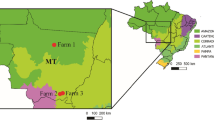Abstract
According to the Kyoto-Protocol for carbon dioxide mitigation the direct human induced sequestration potential of carbon in agricultural soils may in the future be included for calculating net changes in greenhouse gas emissions. Therefore we used long-term experiments on arable land in Austria differing strongly in climate and soil conditions to explore the effects of agronomic practices on changes in soil organic carbon content. Optimal mineral N fertilizer input increased the carbon stocks on an average to 2.1 t ha−1compared with no N fertilization in a 36 years period. Additional farm yard manure application (10 t ha−1 y−1) enhanced carbon storage to about 5.6 t ha−1 after 21 years. Site-specific influences must be considered. Losses of 2.4 t carbon per ha were caused by additional irrigation of sugar beet and maize in a rotation with cereals in a 21 years period. The incorporation of all crop residues resulted in an increase of 3.4 t ha−1 organic carbon in topsoil after 17 years. In the uppermost soil layer (0–10 cm) minimum and reduced tillage treatment enhanced carbon stocks to about 4.7 t ha−1 and 3.2 t ha−1 compared to conventional soil management within a decade. Based on these results, only a limited soil carbon sequestration potential can be inferred: Manuring and incorporation of crop residues are well-proven practices on arable land and therefore no additional human induced carbon sequestration might be achieved. The adoption of minimum tillage on Phaeozems, Chernozems and Kastanozems could, roughly calculated, result in a supplementary carbon storage of about 0.6% of the entire present annual carbon dioxide emission in Austria. However, the storage of carbon in topsoil means only a mid-term sequestration. By changing practices in short-terms, these amounts of carbon might be a source of additional carbon dioxide in the future.
Similar content being viewed by others
References
Batjes NH (1998) Mitigation of atmospheric CO2 concentrations by increased carbon sequestration in the soil. Biol Fertil Soils 27(3): 230–235
Bolin B & Cook RB (1983) The major biomechanical cycles and their interactions. Scope 21, John Wiley and Sons, New York
Falloon PD, Smith P, Smith JU, Szabo J, Coleman K and Marshall S (1998) Regional estimates of carbon sequestration potential: Linking the Rothamsted Carbon Model to GIS Databases. Biol Fertil Soils 27(3): 236–241
FCCC (1998) Framework convention on climate change/ Subsidiary body for scientific and technological advice/ Inf.1: Methodological Issues
FMEYF (1997) Second national climate report of the austrian federal government. Federal Ministry of Environment, Youth and Family Affairs, Vienna
Franko U & Oelschlägel B (1995) Effect of climate and texture on the biological activity of soil organic matter turnover. Arch Agron Soil Sci 39: 155–163
Friedel JK, Munch JC & Fischer WR (1996) Soil microbial properties and the assessment of avoidable soil organic matter in a haplic luvisol after several years of cultivation and crop rotation. Soil Biol Biochem 28(4–5): 479–488
Houghton RA & Woodwell GM (1989) Globale Veränderung des Klimas. Spektrum der Wissenschaft Juni 1989, 106–114
Kandeler E, Tscherko D and Spiegel H (1999) Long-term monitoring of microbial biomass, N mineralisation and enzyme activities of a Chernozem under different tillage management. Biol Fertil Soils 28: 343–351
Körschens M (1997) The most important long-term field experiments of the world - overview - importance - results. Archiv Agron Soil Sci 42: 157–168
Körschens M, Weigel A and Schulz E (1998) Turnover of soil organic matter and long-term balances - tools for evaluating sustainable productivity of soils. J Plant Nutr Soil Sci 161: 409–424
Krupenikov IA & Filipchuk VF (1996) Irrigation of Chernozems of the pontic-danubian facies. Eurasian Soil Sci 28(2): 43–51
Lal R & Kimble JM (1998) Soil conservation for mitigating the greenhouse effect. Adv Geoecology 31: 185–192
Liang BC, Gregorich EG, MacKenzie AF, Schnitzer M, Voroney RP, Monreal CM & Beyaert RP (1998) Retention and turnover of corn residue carbon in some eastern canadian soils. Soil Sci. Soc. Am. J. 62: 1361–1366
Potter KN, Jones OR, Torbett HA and Unger PW (1997) crop rotation and tillage effects on organic carbon sequestration in the semiarid southern great plains. Soil Sci 162(2): 140–147
Smith P, Powlson DS, Glendining MJ & Smith JU (1997) Potential for carbon sequestration in european soils: preliminary estimates for five scenarios using results from long-term experiments. Global Change Biol 3(1): 67–79
Walkley A & Black IA (1934) An examination of the Degtjareff method for determining soil organic matter and proposed modification of chromic titration method. Soil Sci 37: 29–38
Author information
Authors and Affiliations
Corresponding author
Rights and permissions
About this article
Cite this article
Dersch, G., Böhm, K. Effects of agronomic practices on the soil carbon storage potential in arable farming in Austria. Nutrient Cycling in Agroecosystems 60, 49–55 (2001). https://doi.org/10.1023/A:1012607112247
Issue Date:
DOI: https://doi.org/10.1023/A:1012607112247




